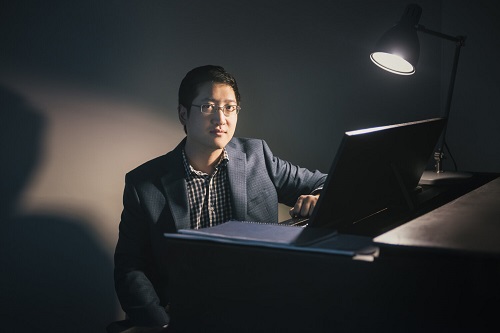 United States TIME:SPANS [2] – ‘Anthony Cheung Portrait’: Claire Chase (flute), Miranda Cuckson (violin), Gilles Vonsattel (piano), Spektral Quartet (Maeve Feinberg & Clara Lyon [violins], Doyle Armbrust [viola], Russell Rolen [cello]). The DiMenna Center for Classical Music, New York, 27.8.2021. (DS)
United States TIME:SPANS [2] – ‘Anthony Cheung Portrait’: Claire Chase (flute), Miranda Cuckson (violin), Gilles Vonsattel (piano), Spektral Quartet (Maeve Feinberg & Clara Lyon [violins], Doyle Armbrust [viola], Russell Rolen [cello]). The DiMenna Center for Classical Music, New York, 27.8.2021. (DS)

Cheung: All Roads, Elective Memory, The Real Book of Fake Tunes
What makes a portrait? What if that portrait is musical, and not a photograph or painting? In TIME:SPANS, New York’s contemporary composer festival, the tenth night of performances was entitled ‘Anthony Cheung Portrait’. Needless to say, it did not involve looking at any painted version of Mr Cheung. In fact, he was on stage, performing one of his pieces. What do we learn about a composer when works have been assembled to paint – albeit musically – his portrait?
First, it is a sign of great proficiency and renown, even for a relatively young composer like Cheung. An evening of music written by one artist requires the programmer to be able to select from a large body of work that relays the composer’s established style. Secondly, a portrait will never succeed at revealing everything: it will instead accentuate certain salient characteristics, sometimes even exaggerating a few in order to make a point. Finally, a concert that paints a composer’s portrait allows the listener to leave with a renewed relationship to the music, one uninterrupted by the possibly disruptive styles of other works on a program.
Cheung, who recently joined the faculty at Brown University, has over the years been commissioned to write for the best and brightest international ensembles (as well as orchestras). He has held many fellowships, culminating in the prized Guggenheim, and his admirable portfolio makes him most deserving of a portrait. With all these accomplishments, Cheung nevertheless humbly and warmly invited us to listen with a welcoming speech.
But what of the message from this portrait? What are the salient characteristics that come forth? Without a doubt, as I discovered, Cheung is greatly loved by musicians. He wrote many years ago for the Chicago-based Spektral Quartet, and they approached the program with a seriousness of interpretation and a dedication, admiration and joy that shone through.
Cheung and Miranda Cuckson played Elective Memory for piano and violin, which they have recorded as well. Cuckson, who consistently dazzles audiences with her cohesive interpretations of new music, showed the deep level at which she had embodied the work and taken care to understand its beauty from all angles. It made for an extraordinarily brilliant performance.
Pianist Gilles Vonsattel joined Spektral for All Roads, and he approached Cheung’s boldness in piano composition with an excitement that anchored the piece with clarity and leadership. For the final work, The Real Book of Fake Tunes, Claire Chase on flute joined the quartet: it was written for her in 2015. Chase performed each of the character pieces as if presenting a gift back to Cheung – taking a composition and lovingly giving it a nurtured, inspired life. Even the musicians of Spektral shone brighter here, with Chase’s enthusiasm goading them to join her in the adventure of giving life to composition.
I was new to Cheung’s work, and I sincerely enjoyed it. But the portrait not only incited me to want to hear more: it succeeded at doing what great portraits – at the Louvre, at the Prado – have done throughout time. I left with a strongly lingering sense of who this person is and how he affects the world. Cheung has a unique ability to revitalize traditional compositional formats and ensemble structures, and his love of piano repertoire and its influence is refreshingly present. Moreover, his courage to write for instruments in a way that allows musicians to take their time to communicate with one another, to pair sounds and textures with clarity and to love their parts is truly reaching a zenith in this craft. I also left with a sense that Cheung was telling stories, relaying messages – ones I needn’t understand but could still feel. The next Anthony Cheung portrait is sure to reveal even more.
Daniele Sahr